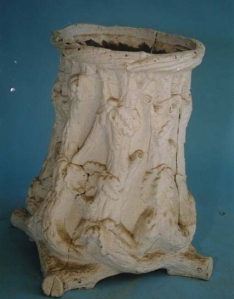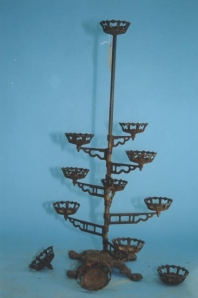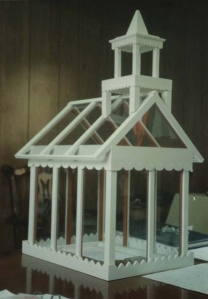Posts tagged ‘horticultural artifacts’
Plants in the Ripley Center: Design for Small Spaces
Next time you visit the Smithsonian museums, take some time to venture into the Ripley Center concourse underneath the Enid A. Haupt Garden. You’ll find the planters lining the walkway there feature a temporary exhibit showcasing gardening styles for small spaces. Five planters host unique interior and exterior vignettes that illustrate a variety of small gardening options. They require little space and are low-maintenance, but add BIG style to any garden.
In selecting a new theme for the plantings in the Ripley Center, I chose to highlight gardening styles that fit urban settings – traditionally smaller spaces for plants – that can be adapted to accentuate any size area. I worked closely with Smithsonian Gardens’ (SG) team of education specialists and collection curators to design this exhibit which features pieces from SG’s historic Garden Furnishings Collection.
Whimsical, magical, fantastic – these are words I think of to describe a fairy garden. My daughter is very much into fairies, princesses, and gnomes – all that wonderful stuff of the Disney variety. For her, this form of gardening in miniature that incorporates fairies and other fantasy creatures IS magic. To me, these gardens have a tale to tell through their use of characters and scenery and spark the imagination of young and old.
My family shares a 1950’s ranch-style house. While there isn’t a lot of room for interior plants, we’re able to fit in some of the styles on display in the modest space. Terrariums are what we use the most at home–on the dining-room table, in the bathroom and bedrooms. Since they can be almost any size, the possibilities are almost endless. A small terrarium can really brighten up a space and add a natural touch, as it has in our 1950’s galley kitchen!
My colleague Janet Draper wrote an interesting post about her planting of a green, or living, wall in the Mary Livingston Ripley Garden. The green wall installed in the Ripley Center is much smaller and less tricky to cultivate than the lovely and large exterior wall that Janet maintains. Green walls have become popular in offices and homes as a way to liven up a wall and provide possible health benefits; they clean the air and increase positive moods.
A stumpery is a garden feature I wish I had known about every time a tree fell in my nestled-in-the-woods childhood home. Utilizing the remains of a tree in inventive ways would have saved my father a lot of chainsaw blades. Through the creative arrangement of stumps and the incorporation of ferns and other shade-loving plants, old stumps can themselves become a focal point within a garden. This style was extremely popular during the Victorian era (1837-1901) and has experienced a resurgence recently.
Dish gardening enables a gardener to create an environment that might otherwise be difficult to sustain. For instance, in the Washington, D.C. area desert plants are not able thrive during our cold and sometimes snowy winters. The desert dish garden in our home has successfully survived multiple harsh winters. Watering and sunlight needs vary depending on the plants one chooses to use in a dish garden, but it’s a great way to grow plants you wouldn’t be able to otherwise.
I’ll be sharing some behind-the-scenes and DIY tips in future blogs. Be sure to catch these plant vignettes in the Ripley Center before exhibit closes on January 31, 2016. I and everyone at Smithsonian Gardens hope you enjoy the exhibit and take away some ideas you might be able to use in your own indoor or outdoor garden.
– Alexandra Thompson, Horticulturist, Interior Plants, Smithsonian Gardens
September 18, 2015 at 9:25 am smithsoniangardens Leave a comment
Auto Vases: an Accessory Born from Necessity

Auto vase, probably manufactured by the Tiffin Glass Company, Tiffin, Ohio. Collection of Smithsonian Gardens.
Imagine yourself after a long day outside; you are driving down the road on a hot summer day with temperatures in the upper 90s. Now imagine there is no air-conditioning in the car; immediately a pungent odor of battery acid hits you and mingles with the stench of the other passengers’ sweat. This experience is not common today thanks to temperature controls that are standard in most cars, but it would have been the case whenever you rode in a car until air conditioners were installed in automobiles in 1939.
There were no pine-scented cardboard trees to dangle from the mirror during this time, and many car owners desperately wanted a reprieve from the foul smell. The auto vase, a term coined by auto magnate Henry Ford, was the solution to the problem. As early as 1895, small vases, which held one or two flowers that emitted a sweet fragrance, became the first automobile air-fresheners.
The auto vase is comprised of a small bud vase with a bracket that allowed it to be mounted inside the car either on the dashboard or by a passenger side window. Vases came in many designs and colors, in a variety of price ranges. They not only improved the smell but also added a touch of elegance to the car interior. Pressed glass, cut crystal, metal, porcelain, ceramic, and even wood were used for the vases, which were often paired with brackets that were fancier than the vases themselves. The fixtures could be made of silver and some were even gold plated. Smithsonian Gardens preserves three examples of these auto vases in its Garden Furnishings and Horticultural Artifacts Collection. One of the three is made from Depression glass with a sky blue satin finish, and is encircled by a nickel-plated bracket.
Auto vases were sold in jewelry stores, auto parts stores, and catalogs from companies such as Sears. Henry Ford was so pleased with these simple solutions that he offered them in his parts department and added them to his system of mass production. The service these vases provided made them a desirable feature to add to any car. With improvements in car batteries and air-conditioning becoming standard in vehicles, the auto vase was no longer necessary. In recent years, however, there has been resurgence in these novelties. Cars such as the Volkswagen Beetle revived these little vases for a fresh twist on their interiors, and drivers of other cars have caught on to the trend.
For more information about auto vases:
Steele, Evie. “For your Limousine.” Classic Car, vols. 23-25. Michigan: Classic Car Club of America, 1975. p. 22-23.
Stout, Sandra. Depression Glass Price Guide. Wayne, PA: Wallace-Homestead Book Company, 1980.
____. “Origin of automobile bouquet holders.” Popular Mechanics, May 1913. Hearst Magazines, 1913. p. 678-679.
Lounsbery, Elizabeth. “Some Automobile Accessories.” American Homes and Gardens, Vol. 10. Munn and Company, 1913.
____. “Flower-Decorated Motor Cars the Vogue.” Automobile Topics, Vol. 18. E.E. Schwarzkopf, 1909. p. 386.
–Janie R. Askew
Research Assistant, Smithsonian Gardens
MA Candidate, History of Decorative Arts
The Smithsonian Associates – George Mason University
What’s in a name?
- A recent donation of a flower frog to the Horticultural Artifacts Collection.
The flower frog is a handy tool used in flower arrangements made by professionals and amateurs. The metal cage flower frog–such as this recent acquisition by Smithsonian Gardens–is the most functional type of frog. Glass and ceramic versions were generally purposed for decoration rather than utility. You may wonder how a little cage came to be called a frog—so do we. The etymology of the name ‘frog’ for these flower-holding devices does not appear in dictionaries. Just as a rose by any other name will, in fact, smell as sweet, the importance of metal caged floral arrangers does not diminish with its ‘froggy’ anonymity.
In 1916, William R. Struck of Dazey Manufacturing patented the first metal cage flower frog. It was designed to be camouflaged by the stems and leaves of a floral arrangement, letting the bouquet speak for itself. Frogs were produced in a wide variety of sizes; some included multiple tiers of cages that allowed for more complex displays. Stems were inserted into the different holes, which anchored them to the device and held them at the same level, giving them equal access to water. The metal cage flower frog could achieve these feats, all while remaining virtually unseen.

Frog Cage, Beagle Mfg. Co., Pasadena, CA. Height 3 1/6 in. x Diameter 7 5/8 in. Horticultural ArtifactsCollection. FJP.1987.323
Garden clubs quickly embraced the metal cages because they permitted more artfully arranged flowers than had been previously possible. Many had complained that vases and decorative frogs made the flowers stick up straight; the metal cage addressed this limitation by allowing flower stems to be inserted at various angles. Publications also promoted these devices over their decorative predecessors because the design of the cage enabled even the amateur floral artist to create dynamic arrangements quickly and easily.These little cages were the dominant type of flower frogs used by both professional and amateur floral artists until 1954 when Oasis was invented. This water absorbent foam developed by Vernon Smithers nearly drove the metal cage flower frogs to extinction. Smithsonian Gardens is fortunate to have a number of them in its Horticultural Artifacts Collection. Though meant to be hidden, they remain an example of one of the greatest innovations in flower arranging of their time.
See more flower frogs in the Smithsonian Gardens’ Horticultural Artifacts Collection.
For further reading: Bull, Bonnie. Flower Frogs for Collectors. Atglen, PA: Schiffer Publishing Ltd, 2001.
Janie R Askew
Research Assistant, Smithsonian Gardens
MA Candidate, History of Decorative Arts
The Smithsonian Associates – George Mason University
Rustic Ornament in the Victorian Garden
This Stump Pedestal is an example of a popular Rustic Style of garden ornament that developed in the late nineteenth century. This style was adapted to the garden from the Romantic Movement, which was characterized by its nostalgic look at nature. Its love of picturesque landscapes was recreated in the garden. The “English Landscape Garden” or “Jardin Anglaise” relied on objects in the rustic style to create an informal setting that put an emphasis on the true nature of the land.

1979.26, Pedestal, Rustic Stump, late 19th C, Cast-iron, paint, 22 x 18 x 13.
These gardens were more sparsely ornamented than other garden styles. Objects were often created using materials found in nature such as tree branches, twigs, roots, bark, pinecones, animal horns, antlers and seashells and were often handmade. Cast-iron, already a popular material used in the garden used molds that would mimic these natural assemblages. As we see in the rustic stump pedestal, it is cast in a high relief and mimics the look of a tree trunk with thick bark that is entangled roots and oak leaves. It would have been used as a base for a plant stand or bird bath and occasionally could have been used a planter itself. These objects were usually painted in white, black, or natural colors that would blend in with the landscape.
Horticulture magazines and other serials provided layout, planting, ornament and structure designs that would have incorporated objects such as the stump pedestal. This was a popular item that can be seen in the 1858, Janes, Beebe, & Co. New York trade catalogue, the 1875, Coalbrookdale Company of England trade catalogue, and the 1893, J.W. Fiske Iron Works trade catalogue.
Many of these rustic style cast-iron ornaments have been broken or damaged. However, gardeners still feature them in their landscapes today. Using the broken pieces and fragments of these antique garden furnishings, they create interesting displays that incorporate the past and create a nostalgic and picturesque setting for the present.
Further Reading:
Israel, Barbara. Antique Garden Ornament: Two Centuries of American Taste. New York: Harry N. Abrams, Inc., 1999.
Himmelheber, Georg. Cast-iron Furniture, and all other forms of iron furniture. London: Philip Wilson Publishers Ltd, 1996
Hill, May Brawley. Furnishing the Old-Fashioned Garden: Three Centuries of American Summerhouses, Dovecots, Pergolas, Privies, Fences & Birdhouses. New York: Harry N. Abrams, Inc., 1998.
-Janie R. Askew
Research Assistant, Smithsonian Gardens
MA Candidate, History of Decorative Arts
The Smithsonian Associates/George Mason University
Victorian Love of Nature, Ornament and Decoration on Display

OH.1985.32, Plant Stand, c. 1850-1900, Cast-iron, 44” x 25.5”
Plant stands such as this, from the Smithsonian Gardens’ Garden Furnishings and Horticultural Artifacts Collection, were the perfect tool to combine a love of nature with a taste for ornament and decoration in the Victorian Era. Named for Queen Victoria of Great Britain, the Victorian Era classifies the period of society and the fine and applied arts during her reign from 1837 to 1901.The cultivation of plants was a widely popular pastime for the Victorians in all levels of society, and their toils were proudly displayed in homes and gardens. Plant stands became an essential item for the exhibit and storage of flowers and foliage. Their practical and decorative benefits were amplified by the link they provided between the domestic interior and the natural world that had gone missing due to the Industrial Revolution.
Plant stands were manufactured in England, America, and France, and came in a variety of forms and materials. Cast- and wrought-iron were the most common materials for garden ornaments such as this; however, they also came in wood, wicker, glass, and ceramic versions and were usually painted white, black, brown, or green. Circular, semi-circular, or squared structures could be positioned against a wall or in the center of a space. Single level and tiered versions were popular, in addition to the plant stand we see here that has multiple appendages.
This type of plant stand was made using separately cast arms attached to a central axis rod. The arms could be rotated and moved vertically along the pole to display plant specimens of various sizes. The cup at the end of each arm would hold a small flower or foliate, which were often in their own removable liner so they could be changed out seasonally.
Plant stands are still a popular indoor and outdoor garden accessory for displaying plants. Just as they did during the Victorian Era, they showcase a selection of seasonal varieties to beautify the home and bring nature within reach.
Further Reading:
Israel, Barbara. Antique Garden Ornament: Two Centuries of American Taste. New York: Harry N. Abrams, Inc., 1999.
–Janie R Askew
Research Assistant, Smithsonian Gardens
MA Candidate, History of Decorative Arts
The Smithsonian Associates/George Mason University
Over Sea and Land … and into the Victorian Parlor

OH.GF.1980.11, Wardian case – Miniature Church, 20th century, Wood, Glass, 27” x 16.5” x 12.5”
Often referred to as the Victorian Era, the nineteenth century was characterized by a growing interest in the collection, preservation, and identification of botanical specimens. New species of plants were carefully imported to England and America from all over the world, and cultivation of these exotics became a popular pastime. This interest was not met without challenges. The soot and pollution from the factories of the Industrial Revolution made it difficult for new plant species to survive. A London surgeon and amateur naturalist, Nathaniel Bagshaw Ward (1791-1868) stumbled upon a solution one day when he noticed that a bulb he had moved to a glass jar, and then forgotten, was thriving in this little habitat. Soon after this discovery, he began making ‘closely glazed cases’ (sic) for growing and extending the life of plants. These glass plant cases, renamed Wardian cases in homage to their inventor, were like tiny greenhouses that were sealed but not airtight. They provided an atmosphere free of pollution with ample light, heat, and moisture ideal for the cultivation of exotics.
The invention of the Wardian case also allowed for new possibilities for transporting plants across long distances. Shipping during the nineteenth century is not what we know today: no priority mail or next-day air delivery options. Railroads, carriages and ships took weeks to deliver plants to a location. Inside a Wardian case the survival rate was considerably higher, as plants were able to travel in a protective environment that provided for their every need.
Despite contributions to the study of botany and improvements to the transportation of plants, the Wardian case is typically associated with household décor rather than invention. Their small size made them accessible to a larger portion of society who could not afford to own greenhouses. Because of their ability to preserve plants indoors, Wardian cases were brought into the parlors and drawing rooms of the Victorian household. This was in large part due to the encouragement of growing and tending to plants as a suitable hobby for young ladies. To suit the Victorian taste for decoration, cases were made to look like miniature buildings such as churches and famous houses. Comprised of a variety of materials that were suited to any price range, they were made in all shapes, sizes, and styles. Their popularity and availability made them a staple of fashionable drawing rooms.
This Wardian case in the Smithsonian Gardens’ Garden Furnishings and Horticultural Artifacts Collection is an example of a nineteenth century innovation and a characteristic feature of the Victorian-era domestic interior in both Britain and America.
Further Reading:
Allen, David Elliston. The Victorian Fern Craze: A History of Pteridomania. London: Hutchinson & Co, 1969.
Whittingham, Sarah. The Victorian Fern Craze. Oxford: Shire Publications Ltd., 2009.
–Janie R Askew
Research Assistant, Smithsonian Gardens
MA Candidate, History of Decorative Arts
The Smithsonian Associates/George Mason University
January 4, 2013 at 10:15 am smithsoniangardens Leave a comment






